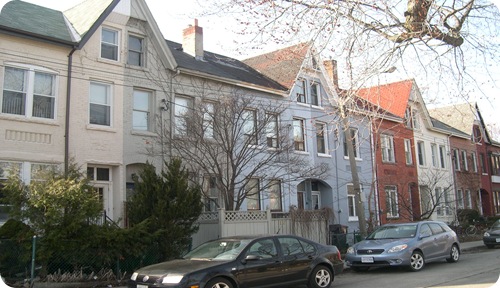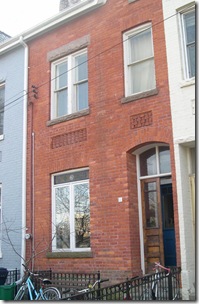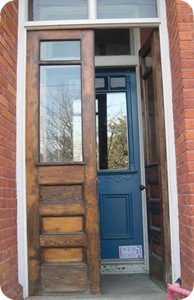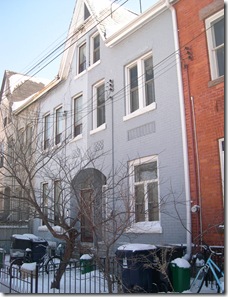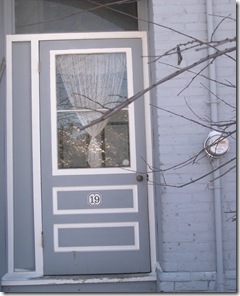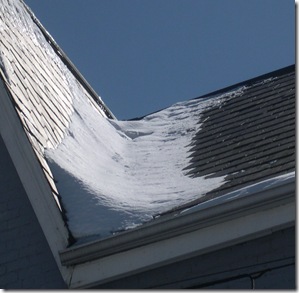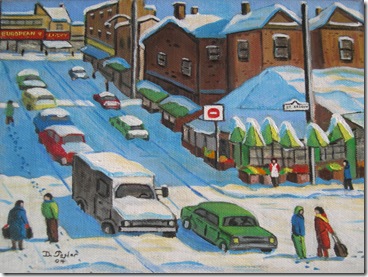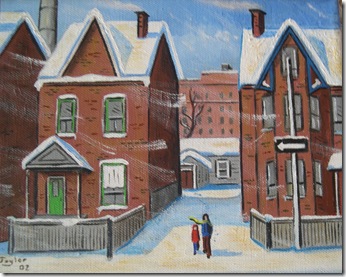Discovering the Kensington Market, a Village Within the city!
In this post, I will examine the row houses on the south side of Bellevue Square.
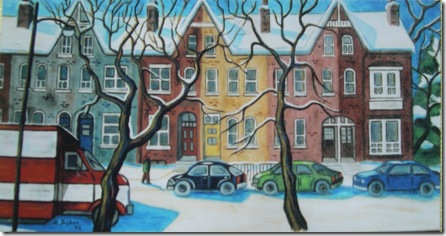
(Acrylic on stretched canvas)
One of the row house that I found interesting was 21 Wales Avenue.
The facade of 21 Wales Avenue (left), and a view of its exterior and inner doors (right)
21 Wales Avenue
The dwelling at 21 Wales Avenue was constructed in 1890, and is an excellent example of row houses built during the latter decade of the 19th century. The first person to live here was Henry (Harry) Hutchinson, who rented the premises from the builder. Hutchinson worked at W. J. Summerville and Company, located at 575 Queen Street West, near Portland Avenue. The shop was within easy walking distance of his home, a true asset in inclement weather. In this decade, many people lived within walking distance of their place of employment. On his journeys to and from work, Mr. Hutchinson undoubtedly greeted his neighbours, sometimes encouraging them to purchase their dry goods, carpets, oilcloth, and rugs from the Queen Street store where he was employed.
One summer day, I passed by this home and its present-day owner, who had recently purchased the property, was busy renovating and restoring the property. He invited me to tour the house.
As I entered, I examined the outer and inner doors. Because it was summer, one of the outer doors was folded back against the walls of the small interior porch. During winter, both doors would be closed to protect the interior of the home against the cold north winds that blow across Bellevue Square. The present-day owner was proud to point out that all the doors were original.
Stepping inside the narrow dwelling, in the front hallway was the staircase, with a handsome post at its base. The owner permitted me to ascend to the second floor. I gently gripped the hand-carved railing as I climbed upward, and thought of the many parents and children that through the decades had similarly held onto this same railing. On the second floor there were three bedrooms, and on the third floor two cozy rooms. I was amazed that such a small house contained five bedrooms.
Returning to the ground floor, I gazed into the parlour, at the front of the house. At the top of the parlour window, the stained glass contained attractive designs. Entering the kitchen, at the rear of the home, I noticed that it possessed a rolled-tin ceiling. The kitchen and parlour were separated by a set of sliding doors, allowing them to be converted into a single space when circumstances demanded.
Throughout the years, many families have lived in this house. For more information on the various residents of 21 Wales Avenue, as well as further details about the interior of this house, see “The Villages Within,” available on Amazon.com and at Chapters/Indigo book stores.
19 Wales Avenue
The other row house that attracted my attention was next door, at 19 Wales Avenue. Though its red-brick facade has been painted gray, it remains an attractive dwelling.
Facade of 19 Wales Avenue, its doorway,
A view of the snow and the slate tiles of the roof at 19 Wales Avenue.
19 Wales Avenue
Constructed in 1890, the same year as 21 Wales Avenue, the house is another fine example of a late-Victorian row house. Its interior would likely be similar to its neighbour, although in reverse. It retains its original slate-rock shingles on the roof, the only house on the street that has this feature. All the other homes have modern shingles.
As I photographed this house in winter, the outer door was shut against the cold. It is unlikely that the outer door is the original.
Paintings of Kensington
Winter scenes of the Kensington Market
“After the Storm,” St. Andrew’s Street and Kensington Avenue (8” by 10”),
looking north to Baldwin Street, the European Meat Market in the distance.
“Houses on the west side of Bellevue Avenue,”
Toronto Western Hospital in background
Acrylic on stretched canvas, (8” by 10”)
My next post will examine the Victorian “Bay and Gable” house at 9 Wales Avenue.
